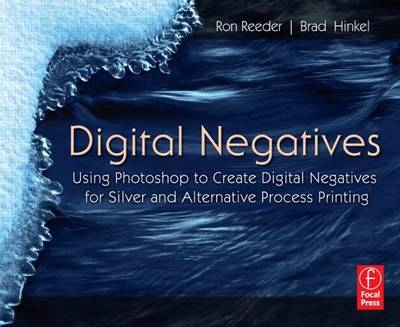
Digital Negatives: Using Photoshop to Create Digital Negatives for Silver and Alternative Process Printing
Focal Press (Verlag)
978-0-240-80854-3 (ISBN)
- Titel ist leider vergriffen;
keine Neuauflage - Artikel merken
Digital Negatives: Using Photoshop to Create Digital Negatives for Silver and Alternative
Process Printing bridges the world of traditional photographic printing with digital technology. A digital negative, prepared in Photoshop, allows you to skip the dark room time developing the negatives-getting straight to a variety of printing processes including silver, platinum, and a host of other "alternative processes. You will see this as an opportunity to mix technology with traditional photo processes resulting in more time for your art! In the recent past, photographers that wanted digital negatives had to take their business to labs. Now all of you Photoshop users can incorporate this practice into your workflow of choice.
Brad Hinkel worked as a program manager for a very large software company in the Seattle area. He helped ship a number of important software products including Word, Mail, and Flight Simulator. He also worked for an Internet retailer in the mid-90's. Brad has been teaching digital photography since 1999. He was largely responsible for starting the digital photography program at the Rocky Mountain School of Photography starting in 1999, and has taught several sections of every course at RMSP. He also created the complete digital photography program at the Photographic Center Northwest in Seattle starting in 2000, and created the entire digital curriculum for that school. Ron was trained as a biochemist and had a career conducting research into gene control mechanisms. Most recently, he directed a laboratory at the Hutchinson Cancer Center in Seattle from which he retired in 2002. As part of that career, Ron published over 100 articles and book chapters in major research journals and wrote numerous grant applications. Thus, Ron has extensive experience in technical writing and exposition. Since retiring from science Ron has pursued a second career in photography. Ron co-published a book on Spruce Root Baskets for which he did the photography. And he has published in national photo magazines. Ron has work for several years conduction extensive research into methods for making high quality digital negatives and has printing many of his own images using these techniques.
Digital Negatives
Introduction
Why digital negatives
The advantages of Photoshop
Renewing challenging processes
A simpler wet darkroom
The handmade print
Can prints from a digital negative match a traditional silver print
Thinking beyond mimicking the silver print
1.The Basics of Digital Negatives
Photographic processes are non-linear
Why this has worked well for so many years
Trying to create a linear workflow in the digital world
Correcting for each printing processes
2.Capturing the Optimal Image
Sources from a digital camera
Exposing onto film
Scanning issues
Color or black & white originals
Processing in Photoshop
3.A Basic Workflow for Silver Printing
The Ingredients
Preparing the image
Printing the negative
Exposure
Development
What might go wrong
4.A Basic Workflow for Palladium Printing
The Ingredients
Coating the paper
Preparing the image
Printing the negative
Exposure
Development
What might go wrong
5.Exposure
Your Light Source
Printing the step table
Determining the base exposure
Measuring exposure
6.Creating Correction Curves
Why we need to create individual correction curves
Identifying a good printed step tablet
Scanning the step tablet
Set the End Points
Measuring the data
Making the correction curve
Testing a correction curve
How we track our curves/processes/prints
7.Calibrating the System
Configuring Grey Working Space
Calibrating your monitor
8.About Printers
Working with some specific Printers we have used
-Epson R2400, 2200, C86 (4000, 4800)
Configuring other types of printers
-Determining the best settings for your printer
-Issues regarding printing
-Print Media
9.Notes on Equipment and Workspace
The Wet workspace
Light Sources for exposure
Is Visible light or UV light printing easier?
10.Tuning the Fine Digital Negative Print
Variable Contrast Paper for Silver Printing
Contrast agents for Palladium Printing
11.Manipulatory Miseries
Some common problems, how these arise and how we address them.
12.Platinum over Color Printing
A new process for color images
CMY - K separations
Printing the color separation
Printing the negative
13.Finishing Techniques
Coating the print - wax, varnish, acrylic
Edge treatments
Framing
14.Experimenting with the Unknown
A list of some experiments that we have tried, our results, and some possible next steps for further experimentations. These include: color & cyanotypes, printing with two negatives, gold prints, uranotypes, digitally creating silver darkroom negatives, localized solarization.
| Erscheint lt. Verlag | 27.11.2006 |
|---|---|
| Verlagsort | Oxford |
| Sprache | englisch |
| Maße | 156 x 234 mm |
| Gewicht | 567 g |
| Themenwelt | Sachbuch/Ratgeber ► Freizeit / Hobby ► Fotografieren / Filmen |
| Informatik ► Grafik / Design ► Digitale Bildverarbeitung | |
| ISBN-10 | 0-240-80854-1 / 0240808541 |
| ISBN-13 | 978-0-240-80854-3 / 9780240808543 |
| Zustand | Neuware |
| Informationen gemäß Produktsicherheitsverordnung (GPSR) | |
| Haben Sie eine Frage zum Produkt? |
aus dem Bereich


